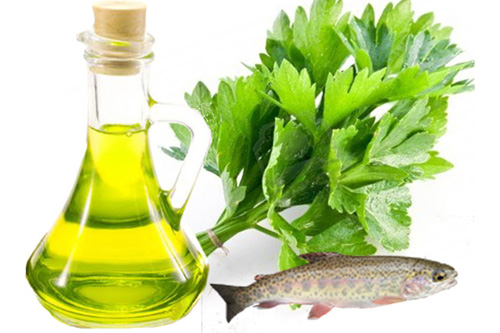Effect of coriander and vegetable oil on rainbow trout

Researchers at the University of Saskatchewan, Department of Animal and Poultry Science, are studying new methods of improving the fatty acid composition of farmed fish. Diets were formulated to be iso-nitrogenous, iso-energetic and iso-lipidic and were based on digestible nutrient values. This is an abstract from the paper.
A 16-wk feeding trial was conducted to examine the effect of adding coriander oil to vegetable oil (VO) diets on the bioconversion of linoleic acid (LA; 18:2n-6) to arachidonic acid (ARA; 20:4n-6) and alpha-linolenic acid (ALA; 18:3n-3) to eicosapentaenoic acid (EPA; 20:5n-3) and docosahexaenoic acid (DHA; 22:6n-3) in rainbow trout.
The experimental treatments were a 4×2 factorial arrangement of diets using four dietary oils (fish, flax, canola and camelina oils) and two levels of coriander oil (0 and 5 g kg−1 inclusion levels). 24 tanks of triploid female rainbow trout (130 g initial weight; n=3) were used in the experiment.
The experiment lasted 112 days during which fish were fed to satiation twice per day. The fatty acid composition of fillets from coriander-fed fish had increased concentrations of 20:5n-3 and 22:6n-3 (P<0.05). Furthermore, a trend to increased (20:5n-3+22:6n-3)/20:4n-6 ratios was seen when coriander oil was added to the diet (P=0.067). These results suggest that the addition of coriander oil to VO diets can significantly increase the bioconversion of 18:3n-3 to 20:5n-3 and 22:6n-3 in rainbow trout.
Randall K. M., Reaney M. J. T., Drew M. D. 2013
Full paper can be found in the Canadian Journal of Animal Science











